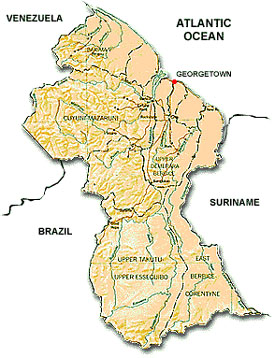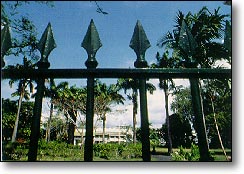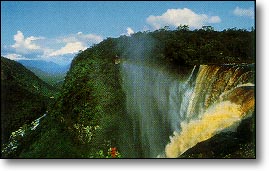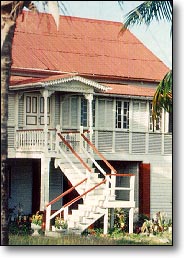
Guyana is South
America's only English speaking country.
This allows tourists from many countries to have an
exciting South American adventure without the
inconvenience of having to learn another language.
|

General Information
Overview | Places
of Interest | Hotels and Tour
Operators
The Basics: 
Capital:
Georgetown
Language:
English & Creolese
Population:
865,200 (estimated)
Religion:
Christianity, Hinduism and Islam
Currency:
Guyana Dollar, but US Dollar is widely
accepted. Foreign currency can be changed at
banks, cambios and hotel.
Time:
Guyana Standard Time. 4 hours behind GMT and
1 hour ahead of EST.
Electricity:
110 and 220 Volts
Entry Requirements:
 All
visitors require passports. Visa are necessary with the
exception of the following: Commonwealth countries, USA,
Belgium, Denmark, France, Germany, Greece, Ireland,
Italy, Luxembourg, the Netherlands, Portugal, Spain,
Norway, Finland, Sweden, Japan, Korea. All
visitors require passports. Visa are necessary with the
exception of the following: Commonwealth countries, USA,
Belgium, Denmark, France, Germany, Greece, Ireland,
Italy, Luxembourg, the Netherlands, Portugal, Spain,
Norway, Finland, Sweden, Japan, Korea.
Visitors are advised to check with the nearest embassy,
consulate or travel agent.
| Departure Tax: |
There is an additional departure
tax when leaving Guyana of G$1,500.00 (approx.
US$10.75) |
| Emergency Numbers: |
Police: 911 , Fire: 912 ,
Ambulance Service: 913 |
| Direct Dialing
(collect): |
Canada - 161, USA - 165, U.K. -
169 |
| Main Towns: |
Georgetown, Linden, New
Amsterdam, Corriverton, Rose Hall, Anna Regina |
The Land:
Guyana extends over
an area of 83,000 square miles (214,969 sq. km) on the
northeast shoulder of the South American continent. The
Atlantic Ocean stretches for 270 miles along the coast of
Guyana, but the country's major thrust is southward and
inland, for a distance of 450 miles. Guyana borders on
Venezuela in the west, Brazil in the south, and Suriname
in the east.
There are three distinct
geographical areas - the coastal belt, the forested and
mountainous area, and the savannah zone.
The narrow coastal belt, a thin
strip only 10 to 40 miles in width (just 4 percent of the
total land area), is intensively cultivated and is home
to 90 percent of the population. The area actually lies
several feet below sea level at high tide, having
been reclaimed in order to take advantage of the
enormously rich alluvial soil deposited by ocean currents
from the Amazon. This coastal belt is protected from the
sea by an elaborate system of dams, walls, and groynes--a
system that is reminiscent of the Netherlands itself,
from which Guyana's first European settlers originated.
 From the
coastal zone, the land rises to a plateau of dense
equatorial forest and swamp. Minerals are found in the
area - the most valuable being bauxite, diamonds, gold
and manganese. Further inland, the forest plateau rises
to the savannah country of the southwest, called the
Rupununi. The sparse population of this area is
predominantly Amerindian. From the
coastal zone, the land rises to a plateau of dense
equatorial forest and swamp. Minerals are found in the
area - the most valuable being bauxite, diamonds, gold
and manganese. Further inland, the forest plateau rises
to the savannah country of the southwest, called the
Rupununi. The sparse population of this area is
predominantly Amerindian.
Guyana is graced by many mighty
rivers, the three most important being the Demerara (on
which is found Georgetown), the Berbice (in the South),
and the Essequibo, which with its many tributaries drains
the greater part of the country.
|
|
Hotel
Directory and Tour Operators:
Hotel
Tower
74-75 Main Street
Tel: 592-2-72011-5
Res: 800-742-4276
Fax: 592-2-65691/56021
|
Cara
Lodge
293 Quamina Street
Tel: 592-2-55301
Fax: 592-2-55310
|
Cara
Suites
176 Middle Street
Tel: 592-2-61612
Fax: 592-2-61541
|
Le
Meridien Pegasus Hotel
Seawall Road
Tel: 592-2-52853-9
Fax: 592-2-60532
|
Wilderness
Explorers:
Guyana's
Nature and Adventure Travel Specialists
61 Hadfield & Cross Streets
Georgetown, Guyana
Tel: 592-2-62085/77698
Climate:
The
climate in Guyana is hot but pleasant for most of the year, particularly
in the coastal belt, which is cooled by the sea breeze. The average
temperature ranges between 75°F and 87°F. The rainy season occurs in
May and June, and then again in December and January, with an average
annual rainfall of 91 inches.
History:
Guyana
derives its name from an Amerindian word meaning "land of many
waters." The area of the Guianas, bounded by the rivers of the
Orinoco in the north and west, the Rio Negro in the west, the Amazon
in the South, and of course the Atlantic Ocean in the East, is believed
to have been settled before 900 AD by Warrau Indians, and later by
the Arawak and Carib tribes. However, there is little archaeological
evidence from these times of substantial settlements.
 In 1595, prompted by the great riches
brought back from South America by the Spanish, Sir Walter Raleigh
embarked from London on an expedition in search of the fabled city
of El Dorado. Raleigh's expedition penetrated hundreds of miles up
the Orinoco River into the Guiana Highlands of present-day Venezuela,
where he found some mineral specimens that contained gold. Upon his
return, Raleigh published The Discoveries of the Large Rich and
Bewtiful Empyre of Guiana, with a relation of the Great and Golden
City of Manoa (which the Spaniards call El Dorado, a book that
if not exactly truthful was certainly quite popular. The region quickly
attracted the interest of the French, the English, and the Dutch,
all of whom soon laid claim to the entire region. It was settled
in separate areas by the three nations, and what is now Guyana occupies
the area of the former Dutch colonies. In 1595, prompted by the great riches
brought back from South America by the Spanish, Sir Walter Raleigh
embarked from London on an expedition in search of the fabled city
of El Dorado. Raleigh's expedition penetrated hundreds of miles up
the Orinoco River into the Guiana Highlands of present-day Venezuela,
where he found some mineral specimens that contained gold. Upon his
return, Raleigh published The Discoveries of the Large Rich and
Bewtiful Empyre of Guiana, with a relation of the Great and Golden
City of Manoa (which the Spaniards call El Dorado, a book that
if not exactly truthful was certainly quite popular. The region quickly
attracted the interest of the French, the English, and the Dutch,
all of whom soon laid claim to the entire region. It was settled
in separate areas by the three nations, and what is now Guyana occupies
the area of the former Dutch colonies.
From 1781
onwards, British influence became increasingly evident, but it was
not until 1814 that the colonies of Essequibo, Demerara and Berbice
were finally ceded to Britain, while the Courts of Policy and Combined
Courts, the legislative and executive bodies created by the Dutch,
remained in operation under British rule for another century. In
1831 the three colonies merged to become British Guiana.
The territory
attained its independence on May 26, 1966 and became a Republican
State on February 23, 1970. |
|
| |
Population:
The
original inhabitants of the territory were Amerindians. However,
to meet the labor needs of the plantation economy, slaves
were brought in large numbers during the 18th and early
19th centuries from West Africa to work on the cotton and
sugar plantations. When slavery was abolished in 1834 the
former slaves refused to work for their former masters,
even for wages. They left the plantations and established
their own village communities. Immigrants were therefore
brought in to work, first from Europe (Germany, Malta and
Portugal), then China, and eventually in large numbers
from India. Today the country's population reflects its
immigrant history with Africans, East Indians, Chinese,
Portuguese, Europeans, and Amerindians living side by
side.
Overview | Places
of Interest

This
page, and all contents of this Web site are Copyright (c) 1996-1997
by interKnowledge
Corp. All rights reserved. |
|


 All
visitors require passports. Visa are necessary with the
exception of the following: Commonwealth countries, USA,
Belgium, Denmark, France, Germany, Greece, Ireland,
Italy, Luxembourg, the Netherlands, Portugal, Spain,
Norway, Finland, Sweden, Japan, Korea.
All
visitors require passports. Visa are necessary with the
exception of the following: Commonwealth countries, USA,
Belgium, Denmark, France, Germany, Greece, Ireland,
Italy, Luxembourg, the Netherlands, Portugal, Spain,
Norway, Finland, Sweden, Japan, Korea.